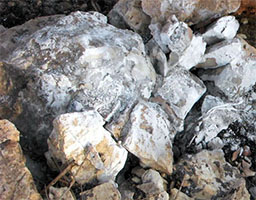 Phosphorus comes from the Latin phosphŏrus , in turn derived from the Greek phōsphóros (which translates as “light-bearer” ). Phosphorus is the chemical element whose symbol is P and its atomic number is 15 .
Phosphorus comes from the Latin phosphŏrus , in turn derived from the Greek phōsphóros (which translates as “light-bearer” ). Phosphorus is the chemical element whose symbol is P and its atomic number is 15 .
With a wide presence in the crust of planet Earth , phosphorus has great importance in biology, since this substance is part of tissues , teeth and bones : that is why it is considered an essential chemical element. . Furthermore, at an industrial level, it is used for the production of multiple products.
Among the characteristics of phosphorus, it can be mentioned that it is a non-metal that is colorless in its pure state. When it comes into contact with oxygen in the atmosphere , it oxidizes and emits light through a phosphorescence phenomenon.
It is important to mention that, beyond its abundance, it is not found native in the natural environment due to its great reactivity . That is why phosphorus is only found as part of various minerals.
White phosphorus , black phosphorus , and red phosphorus are some of the most common allotropes of phosphorus. It should be remembered that allotropy is the property of certain chemical elements to present different molecular or physical characteristics.
In the environment, we usually find phosphorus in the form of phosphate . This is a series of substances of great importance for our body, since they are found in the content of DNA and collaborate in the distribution of energy. Phosphates usually appear in plants; In the field of agriculture, the use of these substances is practiced through fertilizer to enhance their presence in plant products.
 On the other hand, it is also artificially included in foods of animal origin, such as cheeses, meats and sauces. It should be noted that an excess of phosphorus can cause health disorders, such as osteoporosis and kidney problems. However, the other extreme is also harmful to us; An abnormal decrease in phosphorus can occur due to excessive use of certain medications.
On the other hand, it is also artificially included in foods of animal origin, such as cheeses, meats and sauces. It should be noted that an excess of phosphorus can cause health disorders, such as osteoporosis and kidney problems. However, the other extreme is also harmful to us; An abnormal decrease in phosphorus can occur due to excessive use of certain medications.
In its pure state, the color of phosphorus is white, and this is its most dangerous known form for our body . The reason is that it is a very powerful poison, which can cause death if we are exposed to it. In fact, it is used in the production of rat poison; If a person ingests a small amount of this product, they may suffer severe stomach upset, nausea and fainting before losing their life. After contact with the skin, it can cause injuries of varying severity.
Phosphorus is used in the production of detergents, fertilizers and fireworks, for example. In any case, its most frequent use appears in the manufacture of a utensil known, precisely, as a match , match or match . A match, in this sense, is made up of a wooden rod whose end has a head covered by a flammable substance. When the match head is rubbed against a certain material, the heat generated by the friction causes a fire to start.
In everyday speech, it is common to hear this word mispronounced, with the omission of its first S : many people tend to say "phosphorus." This largely depends on the accent of each region, although in some cases the level of education also influences. Although in Spain, Mexico, Nicaragua, Chile and Argentina, among other countries, we speak the same language, the variety of accents that exists between them and within each of them is considerable, and this causes the same term to be used Play in many different ways.
